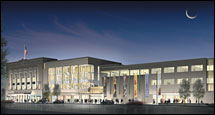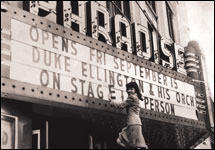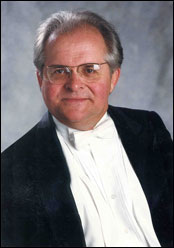MLUI / Articles from 1995 to 2012 / Saving Detroit’s Orchestra Hall
Saving Detroit’s Orchestra Hall
Heroic effort sparks ongoing revival of once-dead neighborhood
September 10, 2003 |
 | |
| All photos courtesy Detroit Symphony Orchestra |
Neither did Mr. Ganson. His leap into the role of chief agitator for saving a renowned building in his hometown surprised everyone. Today, history offers a bigger surprise. When Mr. Ganson and his allies successfully saved Orchestra Hall, one of the world’s most acoustically perfect buildings, it indirectly gave a big push to other Detroit revitalization projects that can still be felt today.
Hold That Wrecking Ball!
Mr. Ganson’s epiphany occurred on September 17, 1970, when he discovered that wrecking balls were about to flatten the grand building. Orchestra Hall’s superb architecture and history were just hours away from crumbling into rubble.
 | |
| Abandoned by the DSO, Orchestra Hall became the Paradise Theater, Detroit’s prestige jazz venue, for a decade, then closed in 1951. |
By the time Mr. Ganson returned to his native city and new job, the hall was in dreadful shape: The roof was collapsing, the walls had gaping holes, crumbled concrete and stone lay everywhere. The place was ripe for demolition. With wrecking balls poised to level the building, Mr. Ganson formed a group with the hall’s former business manager, Richard Magon. They called everyone they knew, pleaded with city officials, and, somehow, managed to delay demolition.
“In the early days we were desperate for help from anybody,” Mr. Ganson recalled of his group, which named itself the Committee to Save Orchestra Hall. “But there is a feeling that one cannot stop. We had to keep on going. It’s the power of the ensemble when we’re at our best as people.”
The Community Pitches In
These newborn activists succeeded in listing the hall on the National Register of Historic Places, raised $100,200 in 24 months, and triumphantly purchased the building. Then they raised more money and repaired it enough to reopen it to public concerts. As concertgoers ventured into the still-spooky building to see an occasional performance produced by a few brave concert promoters, more good things happened.
“There was no one who came to Orchestra Hall — a workman or a professional — without saying, ‘I want to do something extra for Orchestra Hall,’” said Mr. Ganson. “Our efforts were aided by what people offered to do, not what they were necessarily contracted to do. The small things really added up.”
The State Historic Preservation Office was instrumental in jumpstarting the project, providing over $400,000 through a now-defunct preservation grant program to assess the building, develop a rehabilitation plan, upgrade plumbing, restore original seating, and refinish floors.
In 1975 the committee replaced the roof and repaired electrical and heating systems. It launched a $7 million, 14-year capital campaign. In 1979 the DSO finally became involved, celebrating the hall’s 60th anniversary with a concert on its mostly restored stage amid plaster dust, grave-looking cracks in the walls, and the nearly obliterated rococo designs that once illuminated the place. That concert convinced skeptics that saving Orchestra Hall was both worth it and possible.
Ten years later, with its restoration almost complete, the DSO permanently relocated to the now-sparkling Orchestra Hall for its first season there in 33 years. A 19-year struggle concluded on a triumphant note.
Success Lifts Neighborhood
But saving Orchestra Hall turned out to be only the first movement of an increasingly ambitious and successful revitalization symphony for the building’s neighborhood.
 | |
| DSO bassoonist Paul Ganson was a founder of the Committee to Save Orchestra Hall. |
A community-wide redevelopment effort had emerged immediately north of Orchestra Hall on both sides of Woodward Avenue, between Mack Avenue and I-94. What became the University Cultural Center Association, a collaboration that began with just four area institutions in 1976, has since grown to include 60 cultural, academic, medical, service, business, and neighborhood organizations working on the area’s physical redevelopment, maintenance, and promotion. Once notorious for its desolation, the area is now among the most vibrant in the city and has renamed itself Midtown Detroit. It includes Wayne State University, the Detroit Medical Center, the Detroit Institute of Art, the Detroit Public Library, and numerous museums, art galleries, bookstores, restaurants, and residences.
In 2003, 16 UCCA members employ 25,596 people at places such as the DIA, the College for Creative Studies, Veteran’s Hospital, the Majestic Theater complex, and the Detroit Science Center. In 2002, 12 UCCA members reportedly drew two million visitors to their facilities.
Midtown Detroit now boasts nine historic districts. Many of the historic churches along Woodward Avenue have revived. Developers are transforming historic buildings into loft apartments, spearheaded by the successful rehabilitation of the Albert Kahn-designed Garfield Building. The project utilized more than $4 million in historic preservation tax credits and includes a Rite-Aid pharmacy that, without coaxing from the developers, would have instead been built nearby as a standard box store.
UCCA and the DIA purchased four Victorian homes and two carriage houses and turned them into an award-winning, 42-room hotel, the Inn on Ferry Street. The $8 million project obtained approximately $1.3 million in state and federal historic preservation tax equities through Comerica and National City banks.
State and City Help
UCCA President Sue Mosey said most Midtown Detroit preservation efforts typically rely on three state programs that aid local historic preservation and community development efforts. Neighborhood Enterprise Zones freeze property taxes at 50 percent of the normal rate for new or improved old homes. The Obsolete Property Tax Abatement Program keeps taxes on restored commercial buildings to pre-restoration levels for 12 years. The Brownfield Investment Single Business Tax Credit grants tax credits for either renovating or demolishing dilapidated buildings.
 | |
| Restoring Orchestra Hall’s rococo architecture and decoration to their original brilliance took almost two decades. |
Several historic preservation tax credits are also crucial to Midtown’s revitalization efforts. The 20-percent federal historic preservation tax credit rewards rehabilitation work on income-producing properties listed in the National Register of Historic Places. Michigan’s 25-percent state preservation tax credit aids the rehabilitation of residential or non-income-producing buildings that contribute to a designated local historic district. A 10-percent federal income tax credit supports the restoration of non-designated buildings built after 1930.
Local economic programs also help. The Real Estate Assistance Fund offers below-market-rate loans for properties deemed crucial to Detroit development. The Detroit Investment Fund has a $52 million private capital pool for business expansion. Detroit Renaissance provides pre-development assistance for proposed projects. Shorebank Enterprises offers loans to first-time homebuyers, small businesses, and real estate developers. Preservation Wayne, the Inner-City Ventures Fund, the Woodward Corridor Development Fund, and other local organizations are assisting revitalization efforts.
Orchestra Hall Expands
Orchestra Hall’s resurrection and all that has followed it now have the area brimming with ambitious projects and stunningly renovated places. Ms. Mosey estimated that, so far, new investment in Midtown Detroit totals $1.83 billion.
A significant amount of that investment — $220 million — is now flowing into the city’s most spectacular cultural project. The DSO is finishing its new addition to that great building — the Max M. Fisher Music Center.
Its September opening will add 135,000 additional square feet of performance, rehearsal, and administrative space to a campus that now includes, in league with the Detroit Medical center, an office complex, restaurant, and parking deck. The former Orchestra Hall box office will become a symphony store; its upper lobby will expand and gain windows overlooking Woodward. The hall will also get a new marquee that replicates the long-lost original.
A Public School Partnership
The DSO is now teamed up with the Detroit Public Schools and Detroit Public Television to help facilitate the building of the $122.5 million Detroit High School for the Fine, Performing & Communications Arts. The 1,200-student facility, to be completed in 2005, will be one of the first environmentally “green” school buildings in southeastern Michigan. Located on the same block as Orchestra Hall, it will house the facilities and staff for the school system’s radio station; staff from the local PBS affiliate will be among the schools faculty. With DSO musicians mentoring the music students, the school promises to be a vital educational institution.
“What makes it all work,” said Don Schmitt, partner in Diamond and Schmitt Architects, which manages the big project, “is to value the heritage and history combined with modern amenities. We want to honor history, retain it, and use it as a vehicle to bring new facilities to the community.”





